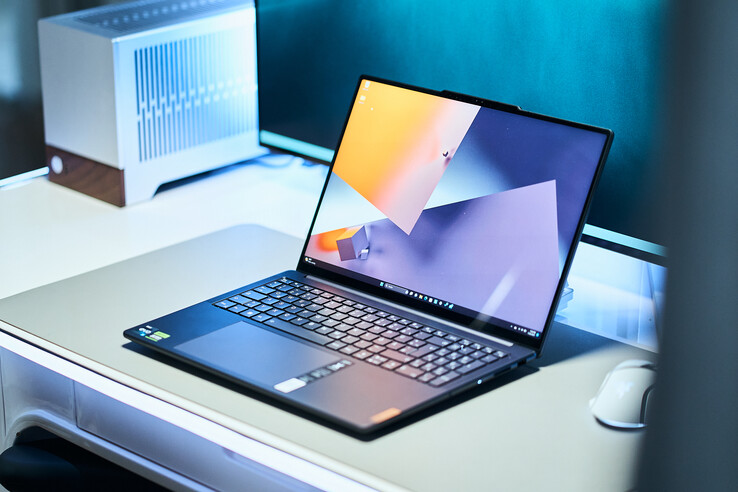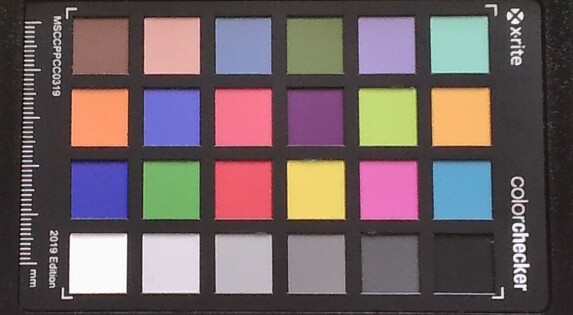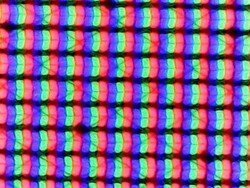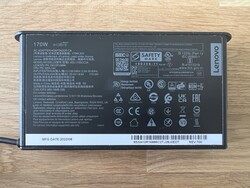Short battery life and less hardware. Lenovo is aiming for the crown in the category of 16-inch multimedia laptops with its new Yoga Pro 9i 16. Its trump card is supposed to be the high-resolution and bright mini-LED panel. However, there are unusual weaknesses in the build quality and, in contrast to the 14-inch model, features such as Advanced Optimus are missing.
Andreas Osthoff, 👁 Andreas Osthoff (translated by Jacob Fisher), Published 08/02/2023 🇩🇪

Having looked closely at the 14-inch version of the new Lenovo Yoga Pro 9i, we now take a look at the 16-inch version. The tech specs (apart from the size) are fundamentally identical, as a 3.2K mini-LED touchscreen with 165 Hz and AdobeRGB coverage is also used here. Under the hood are the latest Raptor Lake H CPUs from Intel and Nvidia GPUs ranging from the RTX 4050 to the RTX 4070. In detail, however, there are some differences which we also take a look at.
Our test device is the 83BY0016GE model and is priced at EUR 2,399 (Translator’s note: models in the US are considerably cheaper – see “Price and Availability” at the end of this review) with a 3.2K mini LED panel (165 Hz), a Core i7 processor, a GeForce RTX 4060, 16 GB LPDDR5X 6400 RAM and a 1 TB PCIe 4.0 SSD. We were also able to run some benchmarks on a more powerful configuration (Core i9, RTX 4070 laptop, 64 GB RAM).
Processor
Intel Core i7-13705H 14 x 1.8 – 5 GHz, 125 W PL2 / Short Burst, 80 W PL1 / Sustained, Raptor Lake-H
Memory
16 GB
, LPDDR5X-6400, Dual-Channel, soldered
Display
16.00 inch 16:10, 3200 x 2000 pixel 236 PPI, capacitive, LEN160-3.2K, Mini-LED, glossy: yes, HDR, 165 Hz
Mainboard
Intel Alder Lake-P PCH
Soundcard
Intel Raptor Lake-P/U/H PCH – cAVS
Connections
2 USB 3.0 / 3.1 Gen1, 1 USB 4.0 40 Gbps, 1 Thunderbolt, USB-C Power Delivery (PD), 1 HDMI, 1 DisplayPort, Audio Connections: 3.5 mm, Card Reader: SDXC, Brightness Sensor
Networking
Intel Wi-Fi 6E AX211 (a/b/g/h/n=Wi-Fi 4/ac=Wi-Fi 5/ax=Wi-Fi 6/ Wi-Fi 6E 6 GHz), Bluetooth 5.1
Size
height x width x depth (in mm): 18.2 x 362.5 x 245 (=0.72 x 14.27 x 9.65 in)
Battery
75 Wh, 4725 mAh Lithium-Ion
Operating System
Microsoft Windows 11 Pro
Camera
Webcam: 5 MP + IR
Primary Camera: 5 MPix
Additional features
Speakers: 6 speakers, 4x 2W woofers, 2x 2W tweeters, Keyboard: Chiclet, Keyboard Light: yes, 170W PSU (SlimTip), 24 Months Warranty
Weight
2.228 kg (= 78.59 oz / 4.91 pounds), Power Supply: 574 g (= 20.25 oz / 1.27 pounds)
Note: The manufacturer may use components from different suppliers including display panels, drives or memory sticks with similar specifications.
The case design is the same as the smaller Yoga Pro 9i 14, i.e. an aluminum construction is used. However, the 16-inch model has a weak point: the base plate is very thin and emits unpleasant creaking noises when handled, which is not at all fitting for a premium device. The problem was also present (albeit less pronounced) in the second test device, so this may be a general problem. This is a pity because there are no defects otherwise in terms of workmanship or stability. The base unit can only be pressed in minimally in the central area, but practically cannot be twisted at all. The lid is a little more flexible than the smaller 14-inch model, but no issues pop up here either. The two hinges are well adjusted (only minimal teetering) and hold the screen securely in place, even at small opening angles. At the same time, one-handed opening of the display is possible and the maximum opening angle is 180 degrees.
Our test unit is the Strom Grey variant, which is very inconspicuous and fits right into the office without attracting attention. Those who like it more colourful can opt for the Tidal Teal (turquoise green) color variant. Overall, the design looks very modern and the screen’s edges are quite narrow, but the camera hump is somewhat annoying because it sits a little deeper than the rest of the screen lid.
Together with the Schenker Vision 16 Pro and the Apple MacBook Pro 16, the Yoga Pro 9i 16 has the smallest footprint in the comparison field, but is also one of the heavier models at just over 2.2 kg, although the differences here are not huge. The only exception is the Vision 16 Pro at just 1.6 kg. The included 170 watt power adapter weighs around 570 grams.
Lenovo Yoga Pro 9 16-IRP G8 Asus ProArt Studiobook 16 OLED H7604 Asus Vivobook Pro 16X K6604JV-MX016W MSI Stealth 16 Studio A13VG Apple MacBook Pro 16 2023 M2 Max Schenker Vision 16 Pro RTX 4070 DIN A4 ❌
362.5 mm / 14.3 inch
245 mm / 9.65 inch
18.2 mm / 0.717 inch
2.2 kg4.91 lbs356 mm / 14 inch
271 mm / 10.7 inch
23.9 mm / 0.941 inch
2.4 kg5.37 lbs355 mm / 14 inch
251 mm / 9.88 inch
22.8 mm / 0.898 inch
2.1 kg4.61 lbs356 mm / 14 inch
260 mm / 10.2 inch
19.95 mm / 0.785 inch
2 kg4.45 lbs355.7 mm / 14 inch
248.1 mm / 9.77 inch
16.8 mm / 0.661 inch
2.2 kg4.76 lbs353.7 mm / 13.9 inch
245.3 mm / 9.66 inch
17.1 mm / 0.673 inch
1.6 kg3.55 lbs297 mm / 11.7 inch
210 mm / 8.27 inch
1 mm / 0.03937 inch
5.7 g0.01257 lbs
Differences to the smaller model are to be found in the ports. Only one USB-C port is installed here, which at least also supports Thunderbolt 4 and can be used for charging if necessary (this worked without issue with a 65-watt power supply). Since there is a dedicated power supply (SlimTip) here, the lack of a second USB port can be overlooked, but we don’t understand why the HMDI output of the 16-inch version supports just the 1.4b standard, which is why 4K can only be output at 30 Hz.
 Left: power supply (SlimTip), USB-A 3.2 Gen 1 (5 GBit/s), HDMI 1.4b, USB-C 4.0 with Thunderbolt 4 (40 GBit/s, DisplayPort-ALT mode 1.4, Power Delivery 3.0), 3.5 mm audio
Left: power supply (SlimTip), USB-A 3.2 Gen 1 (5 GBit/s), HDMI 1.4b, USB-C 4.0 with Thunderbolt 4 (40 GBit/s, DisplayPort-ALT mode 1.4, Power Delivery 3.0), 3.5 mm audio
 Right: webcam e-shutter, power button, SD card reader, USB-A 3.2 Gen.1 (5 Gbit/s, powered)
Right: webcam e-shutter, power button, SD card reader, USB-A 3.2 Gen.1 (5 Gbit/s, powered)
The card reader on the right takes regular SD cards, which protrude about 2 cm from the device. The transfer rates in conjunction with our Angelbird AV Pro V60 reference card are around 80 MB/s. This is an average value that is clearly surpassed by some competitors.
A port for wired network connections is not available, but this can be implemented via an optional USB adapter. Intel’s AX211 module, which also supports the current Wi-Fi 6E standard, is responsible for wireless connections. We measured high and stable transfer rates with our Asus reference router. No issues arose in practice either, neither in large data transfers nor downloads.
iperf3 transmit AXE11000
1618 (min: 1527) MBit/s ∼99%
iperf3 receive AXE11000
1547 (min: 1409) MBit/s ∼89%
iperf3 transmit AXE11000
1630 (min: 1571) MBit/s ∼100%
iperf3 receive AXE11000
1687 (min: 1665) MBit/s ∼97%
iperf3 transmit AXE11000
1444 (min: 1147) MBit/s ∼89%
iperf3 receive AXE11000
1714 (min: 1675) MBit/s ∼99%
iperf3 transmit AXE11000 6GHz
1492 (min: 1095) MBit/s ∼86%
iperf3 receive AXE11000 6GHz
1732 (min: 1669) MBit/s ∼96%
iperf3 transmit AXE11000
1612 (min: 1550) MBit/s ∼99%
iperf3 receive AXE11000
1735 (min: 1691) MBit/s ∼100%
iperf3 transmit AXE11000
1325 (min: 977) MBit/s ∼81%
iperf3 receive AXE11000
1364 (min: 675) MBit/s ∼79%
iperf3 transmit AXE11000 6GHz
1612 (min: 1573) MBit/s ∼93%
iperf3 receive AXE11000 6GHz
1446 (min: 731) MBit/s ∼80%
iperf3 transmit AXE11000 6GHz
1730 (min: 1700) MBit/s ∼100%
iperf3 receive AXE11000 6GHz
1803 (min: 1749) MBit/s ∼100%
05010015020025030035040045050055060065070075080085090095010001050110011501200125013001350140014501500155016001650Tooltip
The slightly thicker camera hump houses a 5 MP camera that delivers good image quality, both for pictures and videos. This removes the need for an external webcam, especially for video conferences. An IR sensor is also installed, which enables facial recognition via Windows Hello. The camera can be deactivated via a small slider on the right side of the case (e-shutter).

12.1 ∆E
10 ∆E
11.2 ∆E
13.7 ∆E
9.4 ∆E
9 ∆E
13.1 ∆E
11.2 ∆E
14.3 ∆E
8.8 ∆E
9.1 ∆E
9.4 ∆E
7.8 ∆E
11.4 ∆E
18.5 ∆E
7.2 ∆E
12.9 ∆E
14 ∆E
1.2 ∆E
8.5 ∆E
9.6 ∆E
10.6 ∆E
10.7 ∆E
2.8 ∆E
ColorChecker Lenovo Yoga Pro 9 16-IRP G8: 10.26 ∆E min: 1.18 – max: 18.48 ∆E
The base plate is secured with a few Torx screws (T5) and comes off easily. You then have access to the two fans, the battery and the two slots for the M.2-2280 SSDs. However, the RAM and the WLAN module are soldered.
Lenovo doesn’t leave the extra case width unused and adds a dedicated number pad to the keyboard. Like in the smaller Yoga Pro 9i 14, the manufacturer installs a comfortable and precise keyboard that also offers sufficient key travel of 1.5 mm. Longer texts can also be typed up without strain. A two-stage white backlight that can be activated automatically via sensor helps in dark environments.
The touchpad of the 16-inch Yoga is even larger and, at 15 x 9.5 cm, offers a lot of space for pointer control and gestures of up to four fingers, which also work very well and reliably thanks to good gliding properties. The lower half can also be pressed down, which is characterized by a very loud and cheap-sound clicking noise. We recommend just tapping the pad for input here. In contrast to the smaller 14-inch model, the touchpad is not in the middle of the case, but is offset slightly to the left.
 Subpixel grid
Subpixel grid
The specs of the display only differ from its smaller sibling in the screen diagonal, as the Yoga Pro 9i 16 also uses a mini LED screen with a resolution of 3,200 x 2,000 (16:10) and a frequency of 165 Hz. The glossy panel also supports touch input. The subjective picture impression is excellent, especially with HDR content. In addition to the mini-LED screen, Lenovo also offers a regular IPS panel (3200×2000 pixels, 165 Hz, sRGB).
There is again a big difference between the SDR and HDR modes: in normal SDR mode the mini-LED backlight is not active and the panel behaves like a normal IPS model. Black content is therefore not completely black and slight halos are also visible. Unlike the 14-inch model, however, the PWM control is different, which is why we were unable to determine response times exactly. Flickering at 5.8 kHz occurs at all brightness levels, but should not be a problem for the vast majority of users.
In SDR mode, the 16-inch mini-LED screen reaches a lower brightness of just around 550 cd/m² (~700 cd/m² for the 14-inch panel), which is roughly on par with the MacBook Pro 16. The black value is 0.18 cd/m² in SDR mode, which is why the contrast ratio is “only” ~3,000:1. This is low compared to other mini-LED or OLED panels, but still very good compared to normal IPS screens.
The black value is just 0 in HDR mode, which is why the contrast ratio is also extremely high. Black content is really black here and you can see the difference very clearly in the two comparison images above. With HDR content, the maximum brightness is then just under 1,100 cd/m², which is significantly lower than that of the 14-inch Yoga and also lower than the manufacturer’s specification of 1,200 cd/m². HDR mode also results in visible blooming due to the mini-LED zones, although the effect is not particularly pronounced here.
Unfortunately, Windows’ HDR implementation still leaves a lot to be desired because the HDR mode has to be activated manually first. This in turn means that Windows no longer offers any color profiles and HDR mode is effectively limited to the sRGB color space.
538
cd/m²542
cd/m²558
cd/m²550
cd/m²539
cd/m²551
cd/m²549
cd/m²545
cd/m²542
cd/m²
Distribution of brightness
LEN160-3.2K
X-Rite i1Pro 2
Maximum: 558 cd/m² (Nits) Average: 546 cd/m² Minimum: 29.5 cd/m²
Brightness Distribution: 96 %
Center on Battery: 545 cd/m²
Contrast: 2994:1 (Black: 0.18 cd/m²)
ΔE Color 1.4 | 0.55-29.43 Ø5.1
ΔE Greyscale 2.2 | 0.57-98 Ø5.4
95.1% AdobeRGB 1998 (Argyll 2.2.0 3D)
99.8% sRGB (Argyll 2.2.0 3D)
97% Display P3 (Argyll 2.2.0 3D)
Gamma: 2.19
Lenovo Yoga Pro 9 16-IRP G8
LEN160-3.2K, Mini-LED, 3200×2000, 16.00Schenker Vision 16 Pro RTX 4070
NE160QDM-NZ1, IPS, 2560×1600, 16.00Asus Vivobook Pro 16X K6604JV-MX016W
Samsung SDC4178 ATNA60BX01-1, OLED, 3200×2000, 16.00Asus ProArt Studiobook 16 OLED H7604
ATNA60BX01-1, OLED, 3200×2000, 16.00MSI Stealth 16 Studio A13VG
AUO26A9, IPS, 2560×1600, 16.00Apple MacBook Pro 16 2023 M2 Max
Mini-LED, 3456×2234, 16.20 Display P3 Coverage
97
68.8
-29%
98.4
1%
99.6
3%
96.4
-1%
99
2%
sRGB Coverage
99.8
98.8
-1%
99.7
0%
100
0%
99.7
0%
100
0%
AdobeRGB 1998 Coverage
95.1
70
-26%
95.8
1%
89.4
-6%
84.8
-11%
88.5
-7%
Response Time Grey 50% / Grey 80% *
14 ?(7.5, 6.5)
13.7 ?(6.7, 7)
2%
1.6 ?(0.8, 0.8)
89%
0.59 ?(0.29, 0.3)
96%
4.4 ?(2.2, 2.2)
69%
80.5 ?(38.5, 42)
-475%
Response Time Black / White *
9.2 ?(2.2, 7)
8.1 ?(3.8, 4.3)
12%
1.4 ?(0.6, 0.8)
85%
0.79 ?(0.34, 0.45)
91%
5.6 ?(2.2, 3.4)
39%
47.2 ?(20.6, 26.6)
-413%
PWM Frequency
5800 ?(100)
120 ?(100)
-98%
240 ?(100)
-96%
14880 ?(100, 500)
157%
Brightness middle
539
384
-29%
347
-36%
349
-35%
424
-21%
504
-6%
Brightness
546
371
-32%
346
-37%
350
-36%
411
-25%
487
-11%
Brightness Distribution
96
88
-8%
97
1%
95
-1%
88
-8%
94
-2%
Black Level *
0.18
0.3
-67%
0.06
67%
0.02
89%
0.37
-106%
0.001
99%
Contrast
2994
1280
-57%
5783
93%
17450
483%
1146
-62%
504000
16734%
Colorchecker dE 2000 *
1.4
3.4
-143%
1.89
-35%
2.1
-50%
3.04
-117%
1.5
-7%
Colorchecker dE 2000 max. *
2.1
9.2
-338%
3.26
-55%
5.5
-162%
7.5
-257%
3.3
-57%
Greyscale dE 2000 *
2.2
3.4
-55%
1.55
30%
1.2
45%
4.34
-97%
2.1
5%
Gamma
2.19 100%
2.16 102%
2.39 92%
2.19 100%
2.32 95%
2.25 98%
CCT
6479 100%
7462 87%
6458 101%
6545 99%
6952 93%
6882 94%
Colorchecker dE 2000 calibrated *
1.3
1.97
2.1
3.04
* … smaller is better
We measured the panel using professional CalMAN software. In the preinstalled Lenovo Vantage software, you can choose between the sRGB, Display P3 and AdobeRGB color profiles. Since Lenovo advertises full AdobeRGB coverage, we also used this profile for our measurements.
The panel’s standard calibration turns out much better than the 14-inch model and the average DeltaE-2000 deviation is already below 3, both for grayscale and colors (no outliers here either). We were unable to confirm the advertised DeltaE value of Lenovo Yoga Pro 9 16-IRP G8Apple MacBook Pro 16 2023 M2 Max
Frequency diagram (checkboxes can be checked and unchecked to compare devices)
Lenovo Yoga Pro 9 16-IRP G8 audio analysis
(±) | speaker loudness is average but good (80.5 dB)
Bass 100 – 315 Hz
(+) | good bass – only 4.9% away from median
(±) | linearity of bass is average (9.1% delta to prev. frequency)
Mids 400 – 2000 Hz
(+) | balanced mids – only 3.2% away from median
(+) | mids are linear (6.5% delta to prev. frequency)
Highs 2 – 16 kHz
(+) | balanced highs – only 2.9% away from median
(+) | highs are linear (3% delta to prev. frequency)
Overall 100 – 16.000 Hz
(+) | overall sound is linear (8.4% difference to median)
Compared to same class
» 5% of all tested devices in this class were better, 1% similar, 94% worse
» The best had a delta of 5%, average was 19%, worst was 45%
Compared to all devices tested
» 1% of all tested devices were better, 0% similar, 99% worse
» The best had a delta of 4%, average was 26%, worst was 134%
Apple MacBook Pro 16 2023 M2 Max audio analysis
(+) | speakers can play relatively loud (86.1 dB)
Bass 100 – 315 Hz
(+) | good bass – only 3.9% away from median
(+) | bass is linear (5.7% delta to prev. frequency)
Mids 400 – 2000 Hz
(+) | balanced mids – only 1.2% away from median
(+) | mids are linear (1.5% delta to prev. frequency)
Highs 2 – 16 kHz
(+) | balanced highs – only 2.5% away from median
(+) | highs are linear (1.7% delta to prev. frequency)
Overall 100 – 16.000 Hz
(+) | overall sound is linear (4.9% difference to median)
Compared to same class
» 0% of all tested devices in this class were better, 0% similar, 99% worse
» The best had a delta of 5%, average was 19%, worst was 45%
Compared to all devices tested
» 0% of all tested devices were better, 0% similar, 100% worse
» The best had a delta of 4%, average was 26%, worst was 134%
 170 watt power supply (SlimTip)
170 watt power supply (SlimTip)
The large 16-inch display is largely responsible for the power consumption in everyday use and we measured up to 24 watts in idle at maximum SDR brightness. By comparison, the smaller 14-inch model consumes 20 watts despite higher brightness. In HDR mode, up to 40 watts is possible. Under load, we briefly see around 177 watts, but this quickly settles at around 170 watts (~160-170 watts during gaming). So the 170 watt power adapter is just sufficient, but there is no room to charge the battery in such situations. A model with 200 or 230 watts would have been the better choice here.
Lenovo Yoga Pro 9 16-IRP G8
i7-13705H, NVIDIA GeForce RTX 4060 Laptop GPU, Samsung PM9A1 MZVL21T0HCLR, Mini-LED, 3200×2000, 16.00Schenker Vision 16 Pro RTX 4070
i7-13700H, NVIDIA GeForce RTX 4070 Laptop GPU, Samsung 990 Pro 1 TB, IPS, 2560×1600, 16.00Asus Vivobook Pro 16X K6604JV-MX016W
i9-13980HX, NVIDIA GeForce RTX 4060 Laptop GPU, Solidigm P41 Plus SSDPFKNU010TZ, OLED, 3200×2000, 16.00Asus ProArt Studiobook 16 OLED H7604
i9-13980HX, NVIDIA GeForce RTX 4070 Laptop GPU, Phison EM2804TBMTCB47, OLED, 3200×2000, 16.00MSI Stealth 16 Studio A13VG
i7-13700H, NVIDIA GeForce RTX 4070 Laptop GPU, Micron 3400 2TB MTFDKBA2T0TFH, IPS, 2560×1600, 16.00Apple MacBook Pro 16 2023 M2 Max
M2 Max, M2 Max 38-Core GPU, Apple SSD AP2048Z, Mini-LED, 3456×2234, 16.20Average NVIDIA GeForce RTX 4060 Laptop GPU
Average of class Multimedia
Idle Minimum *
10.9
8.6
21%
13.8
-27%
12.8
-17%
11
-1%
5.2
52%
12 ?(6 – 24.5, n=13)
-10%
7.34 ?(2.4 – 34.6, n=102, last 2 years)
33%
Idle Average *
22.6
12
47%
16
29%
19.9
12%
18
20%
16.5
27%
16.8 ?(8.8 – 29.2, n=13)
26%
11.7 ?(4.6 – 43, n=102, last 2 years)
48%
Idle Maximum *
23.5
12.4
47%
19
19%
20.3
14%
19
19%
16.8
29%
20.2 ?(11.9 – 42.7, n=13)
14%
14.4 ?(5.6 – 44.9, n=102, last 2 years)
39%
Load Average *
84.6
80
5%
147
-74%
131.4
-55%
91
-8%
113
-34%
105.7 ?(77 – 190, n=13)
-25%
75 ?(14.3 – 147, n=101, last 2 years)
11%
Witcher 3 ultra *
159.5
147.7
7%
147.8
7%
196.5
-23%
130
18%
92
42%
Load Maximum *
177.3
173.1
2%
244
-38%
246.8
-39%
228
-29%
145
18%
218 ?(99 – 284, n=13)
-23%
114.2 ?(38 – 247, n=101, last 2 years)
36%
* … smaller is better
0102030405060708090100110120130140150160170Tooltip
0102030405060708090100110120130140150160Tooltip
Lenovo also equips the Yoga Pro 9i 16 with a 75 Wh battery. In view of the higher consumption rates, one can be forgiven for already assuming that the battery life is bound to be even worse than in the 14-inch model. At 150 cd/m² (corresponding to 50% of the maximum SDR brightness) and 60 Hz, the results are still okay with 6.5 hours in the WLAN test (165 Hz: ~5.5 hours) and 7.5 hours in the video test. But as soon as you use high brightness and/or the higher frequency of 165 Hz, it becomes problematic. At full SDR brightness, our Wi-Fi test only lasts a little over 3.5 hours at 60 Hz and 15 minutes less at 165 Hz. An HDR video with full brightness drains the battery completely in just 133 minutes.
In view of these results, Lenovo should have installed a bigger battery instead of the second M.2 slot or at least given the customer the choice. The charging process is very linear up to 80% and takes 48 minutes to get there. The complete charging process takes 87 minutes when the device is switched on.
Battery Runtime
WiFi Websurfing (Edge 114)
6h 25min
WiFi Websurfing max. Brightness (Edge 114)
3h 41min
Big Buck Bunny H.264 1080p
7h 29min
Load (maximum brightness)
0h 44min
Lenovo Yoga Pro 9 16-IRP G8
i7-13705H, NVIDIA GeForce RTX 4060 Laptop GPU, 75 WhSchenker Vision 16 Pro RTX 4070
i7-13700H, NVIDIA GeForce RTX 4070 Laptop GPU, 80 WhAsus Vivobook Pro 16X K6604JV-MX016W
i9-13980HX, NVIDIA GeForce RTX 4060 Laptop GPU, 90 WhAsus ProArt Studiobook 16 OLED H7604
i9-13980HX, NVIDIA GeForce RTX 4070 Laptop GPU, 90 WhMSI Stealth 16 Studio A13VG
i7-13700H, NVIDIA GeForce RTX 4070 Laptop GPU, 99.9 WhApple MacBook Pro 16 2023 M2 Max
M2 Max, M2 Max 38-Core GPU, 99.6 WhAverage of class Multimedia
H.264
449
470
5%
319
-29%
358
-20%
462
3%
1124
150%
604 ?(269 – 1124, n=51, last 2 years)
35%
WiFi v1.3
385
467
21%
390
1%
334
-13%
466
21%
887
130%
535 ?(225 – 1016, n=102, last 2 years)
39%
Load
44
77
75%
88
100%
65
48%
142
223%
66
50%
95.7 ?(39 – 247, n=81, last 2 years)
118%
Pros
+ extremely bright mini LED panel with AdobeRGB and excellent image quality
+ high system performance
+ GPU overclocking
+ very comfortable keyboard
+ good speakers
+ almost always silent in everyday use
+ SD reader & 5 MP webcam
+ 2x M.2 2280 SSD
Cons
– noisy fans when gaming
– short battery life when using the bright display
– RAM not upgradeable
– creaking base panel
– flickering at all brightness levels
– no Advanced Optimus and HDMI 1.4 only
The Yoga Pro 9i 16 is supposed to be Lenovo’s most powerful and best multimedia notebook. Compared to the smaller Yoga Pro 9i 14, however, one has the impression that the manufacturer has made cuts in several areas on the 16-inch model. But first of all, the performance is overall very good and both the main components, namely the CPU and GPU, are faster than in the 14-inch model. So we wonder why the Yoga Pro 9i 16 does not offer Advanced Optimus and why the HDMI port only supports the 1.4b standard. Consequently, 4K displays can only run at 30 Hz, which does not conform to the current level of technology and does not match the high price. Also problematic is the decision to make the RAM soldered. On the topic of the case, another thing that bothers us is the creaking base plate.
The glossy mini-LED panel looks fantastic, especially with HDR content, and also offers accurate color reproduction in addition to complete AdobeRGB coverage. Unfortunately, the measurements are worse here than in the 14-inch model; the manufacturer appears to have put in less work here, since the large 16-inch model flickers at all brightness levels. The large display also has high energy consumption rates, so we cannot understand why Lenovo has not installed a larger battery.
The Lenovo Yoga Pro 9i 16, on its own terms, is a very good multimedia notebook with a great mini-LED panel, high performance, good keyboard and fantastic speakers. However, Lenovo has cut back in several areas and there are certain drawbacks compared to the smaller 14-inch model, which is incomprehensible.
Of course, there are lots of positive aspects. We’ve already mentioned the solid performance values along with the good keyboard, numpad and excellent speakers. Excluding the creaking base panel, the case is very good and the build quality very stable. Lastly, the 16-inch model also offers a second SSD slot.
The battery life is very poor overall and definitely a weakness. The Apple MacBook Pro 16 thus has a massive advantage here despite its excellent and bright mini-LED panel. Windows-equipped rivals with OLED displays such as the Asus Vivobook Pro 16X or Asus Studiobook 16 OLED fare no better here and are clearly behind in regard to screen brightness. IPS rivals Schenker Vision 16 Pro and the MSI Stealth 16 Studio have advantages such as matte displays and no PWN flickering, but do not support HDR.
In Lenovo’s US store, a variant with the Core i9-13905H, RTX 4060 and 32 GB RAM is currently available for $2,199.99.
Prices are as of 02.08.2023 and are subject to change.
Lenovo Yoga Pro 9 16-IRP G8
–
07/31/2023 v7
Andreas Osthoff
Connectivity
68 / 80 → 85%
Games Performance
99 / 90 → 100%
Application Performance
95 / 90 → 100%
Multimedia – Weighted Average
More articles related to this device
Lenovo Yoga Pro 9 16-IRP G8 (Yoga Pro 9 16 Series)
Transparency
The present review sample was made available to the author as a loan by the manufacturer or a shop for the purposes of review. The lender had no influence on this review, nor did the manufacturer receive a copy of this review before publication. There was no obligation to publish this review.

Editor of the original article: Andreas Osthoff – Managing Editor Business Laptops – 1515 articles published on Notebookcheck since 2013
I grew up with modern consumer electronics and my first computer was a Commodore C64, which encouraged my interest in building my own systems. I started working as a review editor for Notebookcheck during my dual studies at Siemens. Currently, I am mainly responsible for dealing with business laptops and mobile workstations. It’s a great experience to be able to review the latest devices and technologies and then compare them with each other.

Translator: Jacob Fisher – Translator – 240 articles published on Notebookcheck since 2022
Growing up in regional Australia, I first became acquainted with computers in my early teens after a broken leg from a football (soccer) match temporarily condemned me to a predominately indoor lifestyle. Soon afterwards I was building my own systems. Now I live in Germany, having moved here in 2014, where I study philosophy and anthropology. I am particularly fascinated by how computer technology has fundamentally and dramatically reshaped human culture, and how it continues to do so.
Andreas Osthoff, 2023-08- 2 (Update: 2023-08- 2)
>>> Read full article>>>
Copyright for syndicated content belongs to the linked Source : NotebookCheck – https://www.notebookcheck.net/Lenovo-Yoga-Pro-9i-16-laptop-review-Great-mini-LED-panel-but-unnecessary-cost-saving-measures.737777.0.html














![[News] Japan Develops 10nm Nanoimprint Technology, with Potential to Tackle EUV Bottleneck – TrendForce](https://earth-news.info/wp-content/uploads/2025/12/329851-news-japan-develops-10nm-nanoimprint-technology-with-potential-to-tackle-euv-bottleneck-trendforce-360x180.jpg)
















